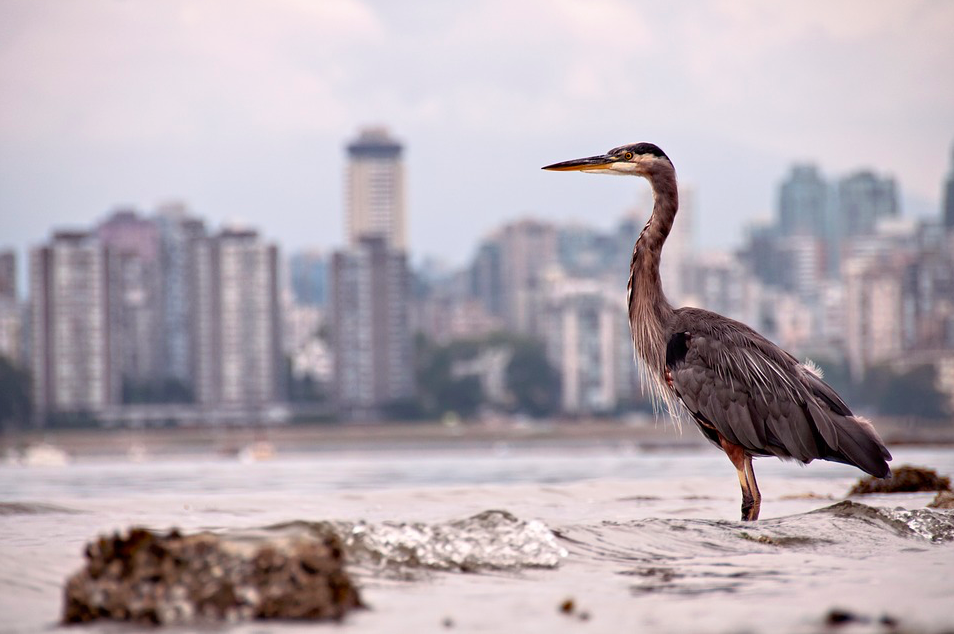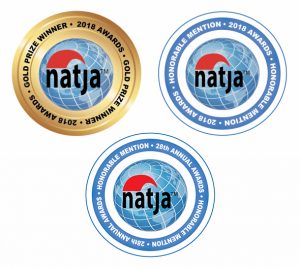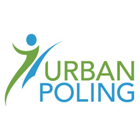Vancouver Summer 2017
Seldom do one’s travels go exactly as planned. I’d anticipated getting outdoors a good deal during my stay in Vancouver, but that was not meant to be. The city was shrouded in heavy smoke from the British Columbia wildfires and experiencing an unusual heat wave.
It’s been HOT, HOT, HOT!
And no place has it been hotter than in the Airbnb that I stayed in.
No air flow to speak of through the condo, and worse yet, no air conditioning.
Seriously?
Apparently in Seattle and Vancouver hot weather is uncommon enough that it is somewhat common not to have any central cooling.
In the future, this is a question I will be asking of any potential places I stay. Because my accommodations, in this very nice condo, have been miserable.
Under normal circumstances, I’d recommend this Airbnb. It’s located in a relatively new building in Chinatown on Keefer street. Great location. It’s within easy walking distance of Gastown and there are two parking garages on the street, one of which is modern and for an urban area, fairly well priced.
The entire Airbnb experience started off well enough. The “owner” (I suspect she was managing this particular unit) was kind enough to meet me a bit early at the property. We chatted. She babbled about the number of properties she has and how the city wanted her to get a business license. She was obviously proud of her growing real estate empire via Airbnb. And capitalizing on what has been the skyrocketing Vancouver real estate market, no doubt. Good for her.
She ran me through the basics of the condo. The keys; how to use the elevator.
I asked about the air conditioning. I am a bit of a utility whore. I can’t stand being too hot.
Suddenly her perfect English disappeared. “Fan, fan” she said, pointing agitatedly to a free standing fan unit in the corner. She turned and practically ran out the door.
I watched as the door closed behind her and the heavy curtains moved in the smokey, hot breeze.
A fan. Really.
I’m pretty adaptable, but the sweat was starting to pour out of me. Rivuets of moisture ran down my face and back as I surveyed the situation.
The sun struggling through the smoky haze was beating its heat into the condo.
The only possible sources of ventilation were two small windows, each in a wall of windows, in the main room and the bedroom. Each window cantilevered out about three inches, barely catching any passing breeze. And there was a door to a small patio.
The patio overlooked the rooftop of a restaurant next door. And on the rooftop were a series of six massive exhaust fans that obviously served the kitchen. I say obviously, because the odor of used cooking oil and Chinese seasonings rose up though the hazy air and into the condo.
Surveying the situation, I guessed that opening the patio door during the late evening into morning, and closing the unit during the mid day heat would offer the best strategy. It would be a tradeoff between sweltering heat and the wafting odors of stale cooking smells.
I got on line to see what my cancellation options were, and what else was available. The cancellation procedures were rather byzantine and definitely not in my favor. The only hotel rooms in town seemed to start at $400-500 dollars per night. Plus parking. Plus taxes. Plus the cost of this Airbnb. Leaving was not really an option.
Ok, let’s see if I can’t manage this. I’ve been through much worse, although at the moment, I can’t recall when.
The first night I simply roasted in the putrid air. There is no relief, just more claustrophobic heat and the wafting odors of dead cooking oil from the building next door. The exhaust fans on the roof below create a palpable hum that reverberates through everything from the air to the mattress.
Here is my review for the Airbnb site on this Vancouver condo:
“The unit has no air conditioning. In the winter with closed windows, this would be irrelevant. It is a very nice unit. But in a smoke filled summer, in a heat wave, this is appalling. The stench of the fried food coming off of the kitchen fans that dominate the roof of the building next door is revolting. The noise is deafening. Even with earphones on, the relentless strumming noise still reverberates through the apartment.
The lack of transparency by the host to note the noise, the odor and note the lack of air conditioning is not ok. It’s particularly not ok for me: I have both asthma and cancer. This is a high heat, noise filled, odor horrific experience I don’t need.
Bottom line, ask a LOT of questions, including surroundings, utilities and refunds under adverse conditions. If you don’t have to open the windows, this is a great place. If you do, be prepared for the gentle squawk of the morning seagulls to give way to the reverberations of massive fan units on the roof next door, followed by stale cooking odors that waft upwards and linger in the condo indefinitely. And should you care for a glass of wine, BYOC (bring your own corkscrew). The kitchen is poorly equipped.”
But finally, 4 nights later, the heat wave is beginning to break and an offshore low is bringing fresh sea air and rain to the area. I have finally slept at least a good part of the night. Well rested (compared to the rest of the sweltering week), I set off to explore Chinatown in a bit more detail.
Vancouver Chinatown
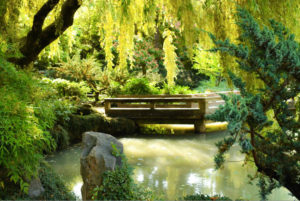
A view in Dr. Sun Yat-Sen’s Chinese Garden, Vancouver, Canada
I am a very visual person. I think about sight lines and patterns as I put together a room or an image (the latter is a fledgling skill). When others show similar thought, I notice. And a place of note for exquisite balance and beauty is the Dr. Sun Yat-Sen Classical Chinese Garden and the attached public gardens.
The art and design of this property integrates yin and yang; references to other world, human and earthly elements. Much like the Bill Reid Gallery, the elements of design have great depth, complexity and often ambiguity which is one of the things that makes them so interesting.
The integration of the past with the present, with an eye to the future evolution of a garden such as this is a monumental task. All great gardens have a timeless depth to them. I once stayed in a bed and breakfast on Cape Cod with a garden designed by Olmsted. Through the tranquility you could feel the love and care that went into its creation. It was a sacred space.
What makes a sacred garden space? I think it’s a space that suspends us in thought, time and place. Its an ageless, soulful experience, that moves through time, day by day and decade by decade.
Here a just a few images of shifting shadows, beautiful vistas, bridges and paths from from Dr. Sun Yat-Sen’s garden:
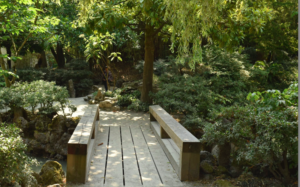
Bridge in the public garden
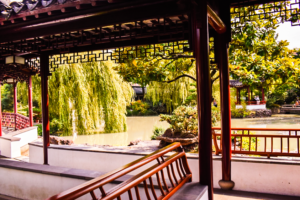
A view into the garden from the teahouse
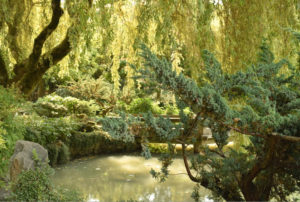
Chinese Garden, Vancouver
This is a magical garden that is well worth a visit. And it’s a great starting point for a walking tour of Vancouver’s Chinatown. From the brochure, allow me to provide a bit of background on this wonderful oasis in the midst of the city:
“The Dr. Sun Yat-Sen Classical Chinese Garden is the first classical garden constructed ouside of China. Its financing and construction represent a unique cooperative effort between Canada, the People’s Republic of China and Vancouver’s Chinese and non-Chinese communities. It is modeled after the highest standards of private classical gardens in the city of Suzhou during the Ming Dynasty (1368-1644).
These Suzhou-style gardens represent the apex of Chinese architecture, philosophy, art and calligraphy.
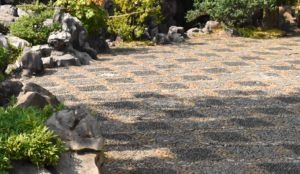
Note the detailed pebble design in the main courtyard
A team of 53 experts from Suzhou spent 13 months constructing the Garden. Working with them were Vancouver architect Joe Wai and the landscape architect Don Vaughan. The materials, tools and techniques used were nearly identical to those used centuries ago. Most of the architectural components were shipped from China; hand fired roof tiles, carved woodwork, lattice windows, limestone rocks and even the courtyard pebbles.
Construction of the Garden began in March 1985. This labouroflove cost $5.3 million (Canadian) and was officially opened in 1986. In June 2004, the $1.9 million new wing, designed by Joe Wai Arcitects and featuring the Hall of One Hundred Rivers, was opened to complement the existing garden spaces.”
On this day, just around the corner, a street fair is taking place. Booths line the streets; vendors inhabit the booths; and people browse.
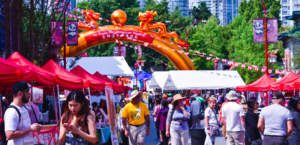
Street fair in Chinatown, Vancouver
In one booth, a potter brings clay to life:
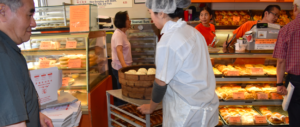
New Town Bakery in Chinatown, Vancouver
I browse the streets, looking for a Chinese bakery I had passed the other day. Since no cruise through Chinatown would be complete without some Dim Sum, I stopped in New Town Bakery and Restaurant. The shrimp dumplings are simply perfect. I tip my imaginary hat to Eva as I enjoy these delicate morsels. Dim sum is available to eat on the premises or to go. The dining facilities are limited, and many people place large orders to go.
This bakery and dim sum restaurant is not an unknown find I can take credit for. It’s been discovered by others as well:
- 2012 : CNN Travel | World’s best Chinatowns : “Must-visit restaurant” in Vancouver Chinatown
- 2010 : Chinese Restaurant Critic’s Choice | Best Chinese Bakery Silver Award
- 2009 : Chinese Restaurant Critic’s Choice | Chinese Pastry Gold Award: Apple Tart
Be sure you discover it too, when you visit Vancouver.
Vancouver Lighthouse Park
In my continued attempts to find relief from the heat, I plotted trips to places near the water, using my (air conditioned) car. This both kept me out of the smoke ridden air and heat, avoided the parking meister in the parking garage (who found countless ways to pad my parking bill), and at least partially avoided the horrifically hot, odorific condo. It also expanded my explorations.
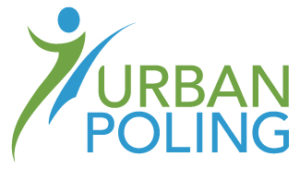
Urban Poles revolutionize the walking experience.
Naturally I drove through Stanley Park. I wish it had been clear enough to see the surrounding hills and mountains. But even in the smoky murk, it is spectacular. I had planned to get my Urban Poles out and walk the perimeter, but it wasn’t meant to be this trip. (If you decide to try a pair of Urban Poles, use the discount code in the right sidebar just for readers of CancerRoadTrip).
Lions Gate Bridge connects the Stanley Park to North and West Vancouver. I can imagine what the city must look and feel like in good weather. But all I can see is smoke and haze.
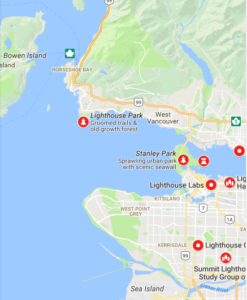
Map-Lighthouse Park
Even under such conditions, Canada is so beautiful. Even the currency is gorgeous. I shall come back for a more extensive trip. But this foray into the northern and western suburbs was wonderful.
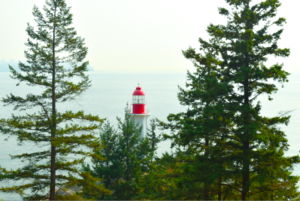
A view of the lighthouse in Lighthouse Park. Note that the smoke totally obscures the view of Vancouver
While still hot, being near the water and in the densely forested walk down to the lighthouse helped still the heat somewhat. And the smoke was slowly starting to break up as the first suggestions of a low pressure system moved into the area.
The park is situated in a rain forest that receives over 50 inches of rain per year. Numerous trails wind their way through the grounds and on this day, a park ranger warned everyone of a bear that seemed to be wandering about as well. Perhaps he too was seeking some relief from the stagnant weather.
Vancouver Maritime Museum
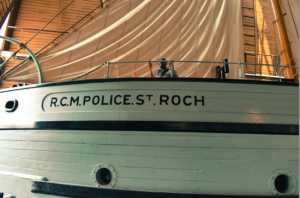
Another heat avoiding possibility presented itself: The Maritime Museum, across the Burrard Street Bridge. In addition to the museum, the walking paths along the water are worth a trip unto themselves. And it was a good 5 degrees cooler, especially in the shade.
Everywhere I go in Vancouver, I am struck by what a human city this is. It’s clean; spectacular; the people are great, and it’s very walkable. The link to the Canadian outdoors is an integral part of life here, even more than in the Seattle area. Vancouver is truly a world class city with world class amenities. And oysters. But that’s another post!
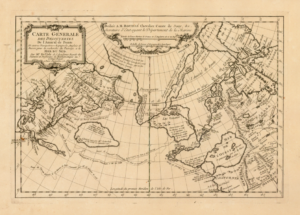
Northwest Passage, an imaginary inland waterway that appeared on maps for many years
The museum turned out to be an absolute delight. For those of you that read this blog regularly, you know that I collect and am endlessly curious about rare maps and the exploration of North America. One of the most interesting aspects (for me) of this museum was the fact that it was the Canadians that finally managed to navigate a Northwest Passage. This museum is dedicated to that effort.
Originally, the Northwest Passage was a 18th century myth made up about a way to navigate from the east coast to the west, via an inland waterway. This myth persisted for years. But an actual Northwest Passage was finally found by the Canadian ship the St. Roch (pronounced ROCK), a Canadian mounted Police Schooner, made of thick Douglas fir, and lined with Australian eucalyptus. In 1940–1942 she became first vessel to complete a voyage through the Northwest Passage, an arctic route, winding through ice blocked passages and an archipelago of islands, in a west to east direction.
The museum features a fully restored St. Roch, right at waters edge. Which means it’s a spectacular location with cooling ocean breezes. I think I won big time with this expedition.
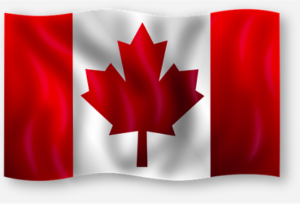
Viva la Canada!
Viva La Canada!
Granville Island
And of course, a visit to Vancouver had to include Granville Island Market:
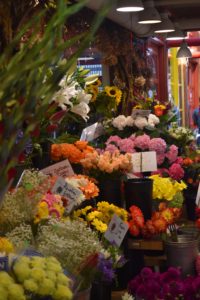
Flowers! At the market!
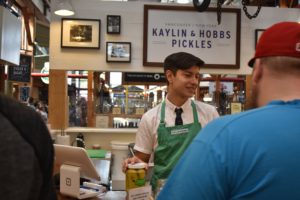
All sorts of vendors are present at the market. This pickle company had an assortment of homemade pickles to die for!
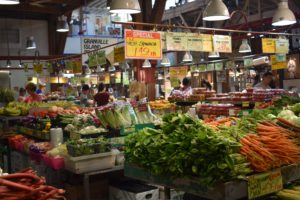
The Pacific Northwest has an amazing assortment of great local food. this stand displays the “usual” assortment of local, fresh produce.
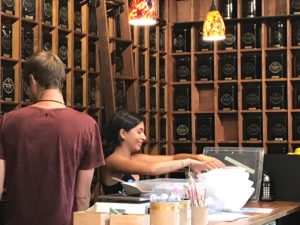
This shop offered all things tea and made the perfect almond milk latte for my morning matcha fix.
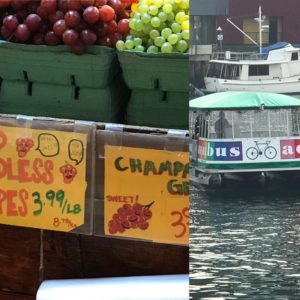
The water taxi brings people to the island market.
More Vancouver Reading:
Back to the Future in Vancouver
The Art of Myth: From Haida to Impressionism
Travel Lessons: Oysters And Whatnot
Like This Post? Pin It!
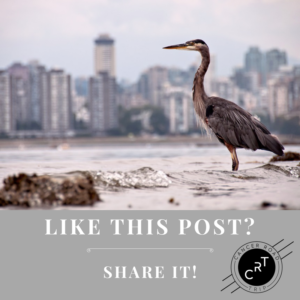
If you’re interested in learning more about photography (or cooking or film or any number of topics) check out Masterclass for on-line excellence:
[et_bloom_inline optin_id=”optin_10″]
What is #CancerRoadTrip and how did it come to be? Read this post to get the backstory!
Follow me on Twitter, Pinterest, Instagram, and at Anti-Cancer Club. Connect with me! I may need a place or two to stay along the way!

